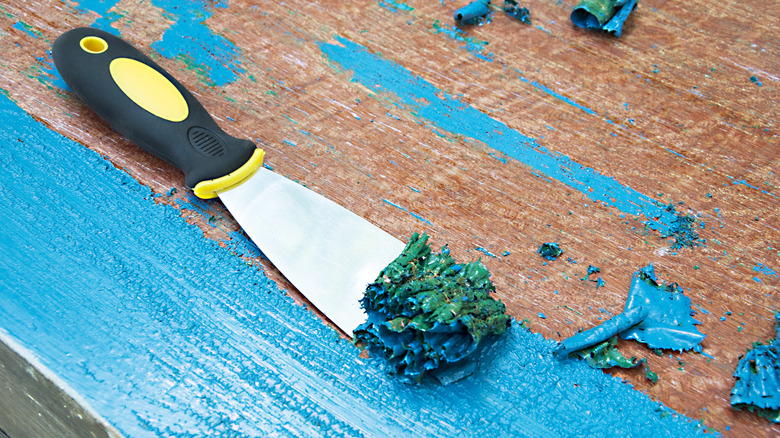How To Use Paint Thinner To Strip Paint
Although paint thinner is traditionally used for thinning oil-based and enamel paint, it also can work for other tasks. You can use it to help remove paint while cleaning up after a project — it works on numerous surfaces to clean up inadvertent spills and drips, but it also works to clean brushes and rollers, allowing you to use them again for the next project. It even works to strip paint from an existing surface, as long as you match the solvent formula to the surface on which you're working. Just apply a thin layer and wait for it to soften the paint before scraping it off. It's not as fast as some other options, but it works nicely when you don't have a stripper chemical available.
Although chemical strippers may be considered the right way to strip paint from wood, you don't necessarily need to spend the extra money when you have thinners available. Rather than disposing of old paint thinner, you can keep it around and use it as a stripping agent for furniture and other items. When stored correctly, solvents like thinners never lose their ability to work. They don't expire or "go bad" like some other liquid mixtures. However, these solvents will evaporate if you leave them uncovered or do not have a tight seal. As long as you have a safe place to store them out of children's reach and away from heat sources, you can keep them indefinitely.
Using paint thinner to strip paint on different materials
Before starting your paint-stripping project, it's important to understand what thinners can and cannot do. You can use this type of solvent on concrete or metal relatively easily. Generally, though, thinner doesn't work well to remove paint from wood unless it is a relatively fresh coat with an oil base. If you have a different plan in mind for use on wood, you can read the container for the solvent to determine whether it's safe to use.
To start, use a brush or rag to apply the thinner onto the surface with the paint you want to remove. Apply it to a small, inconspicuous area at first to be certain it will work without obviously showing damage. The can of solvent should tell you how long to let the thinner sit before trying to remove it, although around 20 minutes usually works for most products like this.
As the solvent works, it should begin softening the paint applied to the wood or metal. It may even bubble. Once it's soft enough, you'll be able to use a plastic scraper to begin peeling it away from the surface. You may have to use a wire brush to scrape older paint away. Should some of the paint come off but not all of it, you can reapply the thinner and try again. Eventually, you should be able to remove all of it.
Safety precautions and what to look out for
While working with paint thinner, it's important always to remember that this is a mineral-oil-based solvent containing many harsh ingredients and chemicals. You do not want to inhale the fumes consistently over a period of time. You also want to try to avoid skin contact as much as possible. Only work with it in a well-ventilated area. Wear protective clothing and gloves while using paint thinner. If it comes into contact with the skin, wash it away as quickly as possible. You may want to wear a mask and safety goggles to protect against splashes.
Do not pour the paint thinner onto the surface. Applying too much can cause some porous surfaces to absorb it. Only use a brush or rag to apply a thin layer. Rather than putting on too much, use thin layers and repeat the application later if needed. If you plan to repaint the item, it's important to wipe away all the remaining solvent afterward.
Additionally, because thinner is not made specifically to remove paint from wood, it may not work on paint applications that were made long ago and that have cured over months and years. For such use cases, you may have to use a specific chemical stripper on the wood. It usually doesn't hurt anything to try the thinner first, though.


